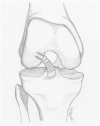Rehabilitation Principles to Consider for Anterior Cruciate Ligament Repair
- PMID: 34344237
- PMCID: PMC9112707
- DOI: 10.1177/19417381211032949
Rehabilitation Principles to Consider for Anterior Cruciate Ligament Repair
Abstract
Context: Injury to the anterior cruciate ligament (ACL) is among the most common orthopaedic injuries, and reconstruction of a ruptured ACL is a common orthopaedic procedure. In general, surgical intervention is necessary to restore stability to the injured knee, and to prevent meniscal damage. Along with surgery, intense postoperative physical therapy is needed to restore function to the injured extremity. ACL reconstruction (ACLR) has been the standard of care in recent decades, and advances in surgical technology have reintroduced the prospect of augmented primary repair of the native ACL via a variety of methods.
Evidence acquisition: A search of PubMed database of articles and reviews available in English was performed through 2020. The search terms ACLR, anterior cruciate ligament repair, bridge enhanced acl repair, suture anchor repair, dynamic intraligamentary stabilization, internal bracing, suture ligament augmentation, and internal brace ligament augmentation were used.
Study design: Clinical review.
Level of evidence: Level 5.
Results: No exact consensus exists on effective rehabilitation protocols after ACL repair techniques, as the variation in published protocols seem even greater than the variation in those for ACLR. For some techniques such as internal bracing and dynamic interligamentary stabilization, it is likely permissible for the patients to progress to full weightbearing and discontinue bracing sooner. However, caution should be applied with regard to earlier return to sport than after ACLR as to minimize risk for retear.
Conclusion: More research is needed to address how physical therapies must adapt to these innovative repair techniques. Until that is accomplished, we recommend that physical therapists understand the differences among the various ACL surgery techniques discussed here and work with the surgeons to develop a rehabilitation protocol for their mutual patients.
Strength of recommendation taxonomy (sort): C.
Keywords: anterior cruciate ligament repair; bridge-enhanced ACL repair; dynamic intraligamentary stabilization; internal bracing; physical therapy; postoperative rehabilitation; suture anchor repair.
Conflict of interest statement
The authors report no potential conflicts of interest in the development and publication of this article.
Figures





References
-
- Achtnich A, Herbst E, Forkel P, et al.. Acute proximal anterior cruciate ligament tears: outcomes after arthroscopic suture anchor repair versus anatomic single-bundle reconstruction. Arthroscopy. 2016;32:2562-2569. - PubMed
-
- Ardern CL, Taylor NF, Feller JA, Webster KE. Fifty-five per cent return to competitive sport following anterior cruciate ligament reconstruction surgery: an updated systematic review and meta-analysis including aspects of physical functioning and contextual factors. Br J Sports Med. 2014;48:1543-1552. - PubMed
-
- Ateschrang A, Ahmad SS, Stöckle U, Schroeter S, Schenk W, Ahrend MD. Recovery of ACL function after dynamic intraligamentary stabilization is resultant to restoration of ACL integrity and scar tissue formation. Knee Surg Sports Traumatol Arthrosc. 2018;26:589-595. - PubMed
Publication types
MeSH terms
Grants and funding
LinkOut - more resources
Full Text Sources
Medical
Research Materials

